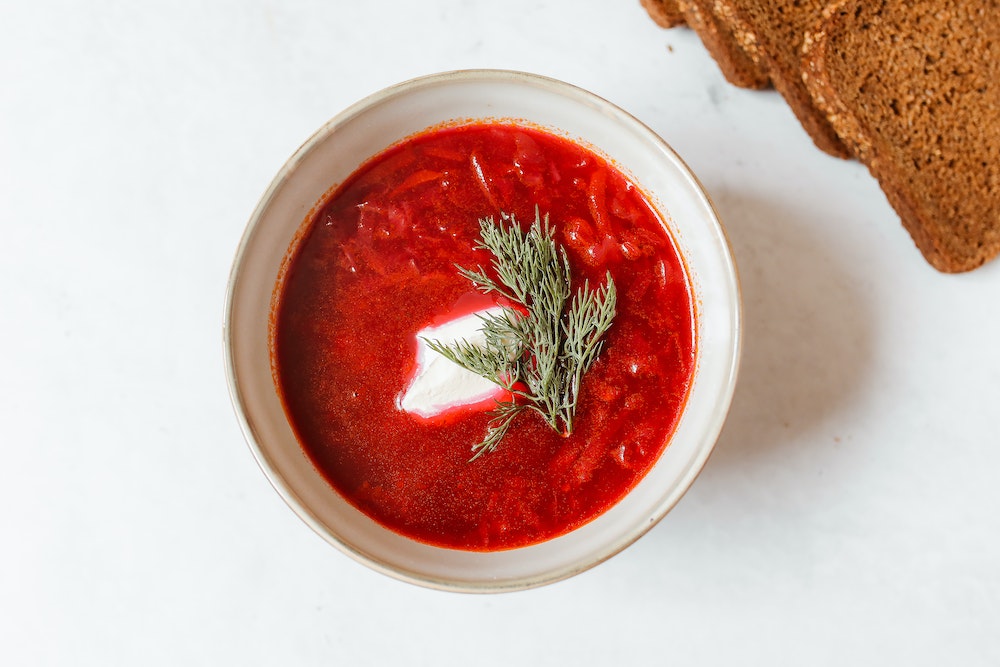Embarking on a culinary journey through Eastern Europe, one cannot overlook the vibrant, ruby-hued delicacy that is red borscht. This article, “The Vibrant Tapestry of Tradition: Delving into the Richness of Red Borscht in Polish and Ukrainian Cultures,” explores the profound cultural significance and cherished traditions surrounding red borscht in Poland and Ukraine. From its historical roots to contemporary adaptations, we unravel the layers of this beloved dish, examining how it serves as a medium of cultural expression and unity, despite regional variations. Join us as we delve into the world of red borscht, exploring its diverse iterations and the stories they tell.
The Roots of Red Borscht: Historical and Cultural Significance in Poland and Ukraine
Red borscht, a quintessential symbol of Polish and Ukrainian culinary heritage, has long been steeped in tradition and history. This soup, characterized by its striking color and rich flavor, transcends mere sustenance to embody the cultural identity and communal spirit of these nations. In Poland and Ukraine, the origins of red borscht are intertwined with folklore and tradition, illustrating its pivotal role in festivals, religious observances, and family gatherings.
In Poland, red borscht is synonymous with Christmas Eve celebrations, where it is served with delicate dumplings, embodying the festive spirit. Similarly, in Ukraine, red borscht graces the tables during significant occasions, accentuating its role in fostering community and continuity. The soup’s recipe, passed down through generations, acts as a vessel for storytelling and cultural transmission, highlighting the shared heritage and distinct regional flavors of Polish and Ukrainian societies.
Moreover, the significance of red borscht extends beyond the culinary realm, reflecting the agrarian lifestyles and historical circumstances that shaped these cultures. The ingredients, such as beetroots, embody the connection to the land and its seasons, while the soup’s preparation and consumption echo the values of hospitality and generosity intrinsic to Polish and Ukrainian ethos.
A Tale of Two Borschts: Comparing Polish and Ukrainian Variations
While the foundational elements of red borscht are consistent, featuring the unmistakable beetroot, the Polish and Ukrainian versions diverge in their nuances, reflecting the unique tastes and preferences of each culture. In Poland, red borscht often leans towards a clearer broth, seasoned with marjoram or garlic, and served with a side of uszka (small dumplings), merging flavors and textures in a harmonious ensemble. In contrast, Ukrainian red borscht typically boasts a heartier composition, incorporating a variety of vegetables, beans, and sometimes even meat, resulting in a robust and nourishing meal.
Exploring the regional variations of red borscht not only highlights the culinary diversity within these cultures but also underscores the adaptability and resilience of this dish. Whether it’s the zesty addition of horseradish in some Polish recipes or the inclusion of smoked pork in Ukrainian variants, each iteration of red borscht tells a story of local preferences, seasonal availability, and historical influences.
Through a comparative lens, we gain insight into how red borscht serves as a canvas for culinary creativity and cultural expression, adapting to the tastes and resources of each region while maintaining its essence as a cherished symbol of heritage.
Ingredients and Rituals: The Making of Red Borscht Across Cultures
Delving into the preparation of red borscht reveals a tapestry of ingredients and techniques that underscore the cultural nuances and personal touches imbued in this cherished dish. In both Polish and Ukrainian traditions, the essence of red borscht lies in its base— a rich and flavorful broth infused with the deep, earthy tones of beetroot, which imparts the soup’s iconic color and nuanced taste profile.
In Poland, the ritual of making red borscht often begins with a fermented beetroot juice starter, which lends the soup a distinctive tang and depth. This meticulous process, evoking the age-old practices of fermentation, showcases the Polish penchant for cultivating complex flavors through time-honored methods. Polish red borscht is typically savored with a dollop of sour cream and a sprinkle of fresh dill, enhancing its richness and aromatic appeal.
Conversely, the Ukrainian approach to red borscht emphasizes a hearty and communal aspect, integrating a medley of vegetables like cabbage, carrots, potatoes, and onions, along with a generous helping of smetana (sour cream) for added creaminess. Often, the preparation of red borscht in Ukrainian homes is a family affair, with each member contributing to the chopping of vegetables or the stirring of the pot, reinforcing the soup’s role in fostering familial bonds and communal spirit.
The making of red borscht in both cultures is imbued with ritualistic significance, often accompanying religious holidays and family milestones, thus cementing its status as a culinary emblem of unity, tradition, and shared memory. Through these meticulous preparation rituals, red borscht transcends its role as a mere dish, embodying the essence of Polish and Ukrainian heritage and the enduring connections it fosters across generations.
Red Borscht on the Global Stage: Adoption and Adaptation
As global culinary landscapes evolve, red borscht has transcended its Eastern European origins, capturing the imaginations and palates of food enthusiasts around the world. This global journey of red borscht not only highlights its universal appeal but also illustrates the dynamic nature of culinary traditions, as they adapt and resonate across different cultures.
Internationally, red borscht has been embraced and adapted in myriad ways, reflecting local tastes and ingredients while retaining its soulful essence. In some regions, chefs have infused red borscht with unconventional components, such as exotic spices or non-traditional vegetables, introducing a fusion of flavors that bridge culinary worlds. Moreover, vegetarian and vegan versions of red borscht have gained popularity, aligning with global trends towards plant-based eating, and showcasing the soup’s versatility and adaptability to dietary preferences.
The proliferation of red borscht on the global stage has also fostered cultural exchange and dialogue, inviting people to explore the rich culinary heritages of Poland and Ukraine. Through international food festivals, cooking workshops, and diverse restaurant offerings, red borscht serves as a culinary ambassador, promoting understanding and appreciation of Eastern European cultures.
By tracing the global journey of red borscht, we witness the transformative power of food as a medium of cultural expression and connection. As it continues to evolve and inspire, red borscht symbolizes the fluidity of culinary traditions, their capacity to adapt and thrive in new contexts, and their enduring ability to unite people across cultural boundaries.









